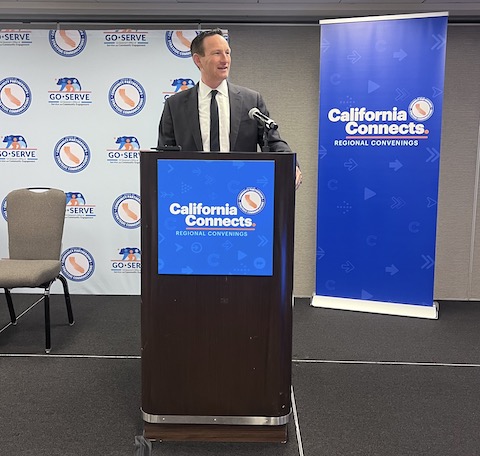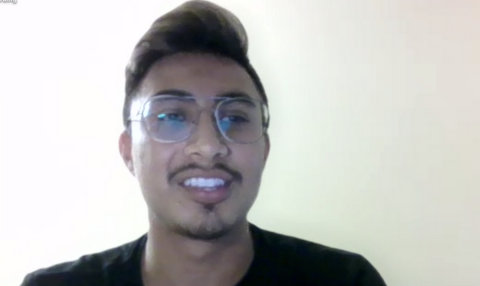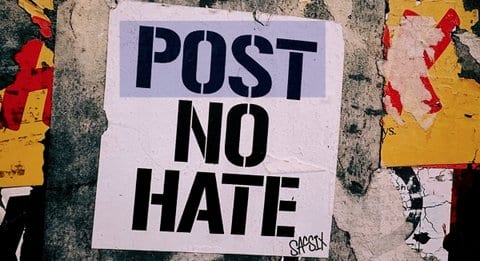
09 Oct State ‘Connects’ Californians With Government Resources and Each Other

“How could the state think about bringing communities together, connecting people in brand new ways?” said Josh Fryday, GO-Serve director and California chief service officer, about the creation of California Connects. (Malcolm Marshall / The CC Pulse)
By Malcolm Marshall
SAN FRANCISCO — California Connects, a series of regional convenings meant to help local groups learn how to access state resources, share ideas and build new partnerships, launched Wednesday in San Francisco.
At a time when federal programs are being cut and public access to information is shrinking, California officials say the state is taking a different approach.
“The contrast is clear,” said Josh Fryday, GO-Serve director and California chief service officer. “As the federal government shuts down, California is stepping up, and we’re powering up. We’re powering up our communities, we’re powering up our leaders and our organizations, and we’re powering up our people. That’s what today is about.”
The San Francisco event was the first of eight gatherings planned across the state. Each will bring together local and state leaders, community-based organizations, ethnic media, schools and philanthropic leaders to find better ways to share state resources with the people who need them most.
The effort is an initiative of the Office of Community Partnerships and Strategic Communications, which is part of the Governor’s Office of Service and Community Engagement.
Fryday said the office was created about a year ago to help government connect more directly with people and communities.
“It’s this new idea of how can the state think about engaging people?” Fryday said at the San Francisco launch. “How could the state think about bringing communities together, connecting people in brand new ways?”
Fryday said the goal is to rethink how government listens to and works with residents.
“We know you can’t engage people when you’re in silos,” he said. “You can’t engage people when you make government resources that are there to help the people extremely hard to get. You can’t engage people when you don’t reach people, when you don’t actually touch people and communicate to people in their language, or where they are, or from the people that they trust.”
He also told attendees the state wants to learn from local communities and build new ways of doing things together.
“Engagement cannot be, and will never be, if we want to do it correctly, a one-way street,” he said. “That’s how government works, at least a government that’s functional and works well. It has to be two ways. So we are here today to have a conversation with you all, to learn from you all, and we’re here to establish what we hope is a new way of doing things.”
State Sen. Scott Wiener, D-San Francisco, also spoke at the event, stressing the importance of local connections and community trust in making government work.
“Government is incredibly important in terms of resources and setting policy and setting some of the structures in place and coordinating and convening,” Wiener said. “But ultimately, everything has to be organized and executed at the local level, and that’s who people trust, people in their community.”
Wiener said it’s the people on the ground who know their communities best and understand what residents need. But he warned that increasing isolation is hurting our society’s overall well-being.
“People have become so disconnected from one another,” he said. “People don’t know their neighbors as well, aren’t as involved in local community organizations, and are spending way too much time online. That’s not just young people; that is older people as well. And so people become super disconnected and, at times, can become propagandized or even brainwashed in some respects, and that is so deeply unhealthy for society.”
He said that disconnection creates space for “scam artists” to exploit fear and division.
“Bad things happen, and scam artists come in and say, ‘I have all the solutions. I’m going to make everything perfect and better and make us, quote, unquote, great again,’ and then we see what happens,” Wiener said.
Wiener said the way to counter that is to continue strengthening local community connections “so that people know there are others in the community who are there for them, who have their backs, who are going to help them.”
Fryday called this an “all-hands-on-deck” moment that requires everyone — elected officials, community-based organizations, philanthropy, and all the 40 million people who call California home — to work together.
“How do we connect them? How do we engage them?” he asked. “How do we inspire them and mobilize them and organize them and make sure they know, every single Californian knows, that they belong to our communities?”
“We are living at a time when many of our leaders in D.C. want to divide us,” Fryday said. “What are we doing here in California? We’re convening. We’re bringing people together. We’re talking about how we collaborate.”
The remaining convenings are Oct. 15 in Los Angeles, Oct. 16 in Anaheim, Oct. 21 in Sacramento, Oct. 23 in Riverside, Oct. 29 in Oxnard, Nov. 5 in San Diego, and Nov. 18 in Fresno. Visit the state Office of Community Partnerships & Strategic Communications online for more details and to register.






No Comments